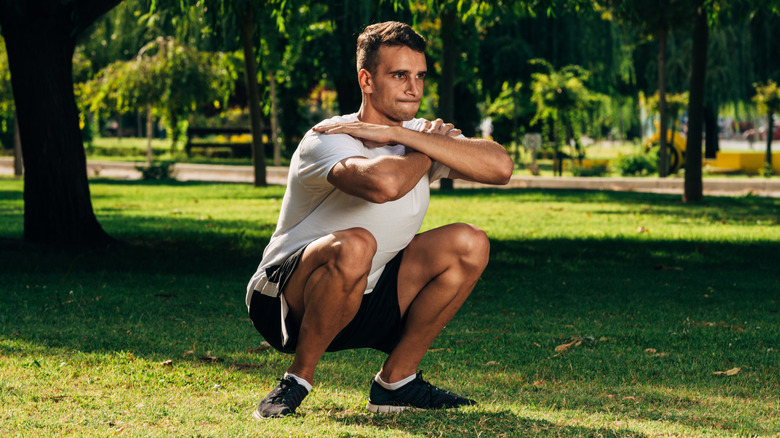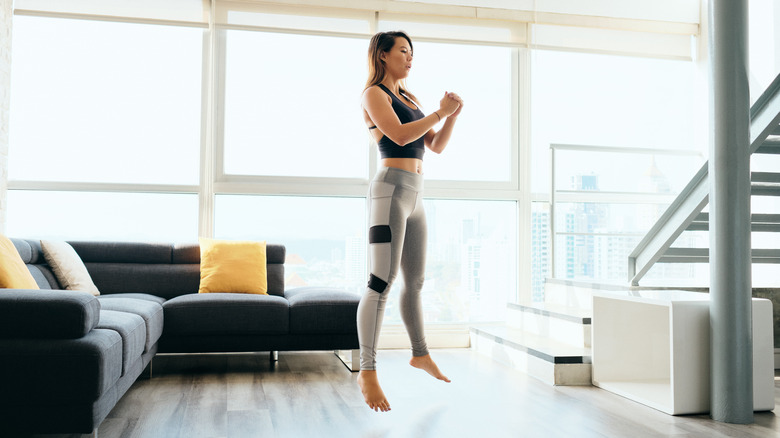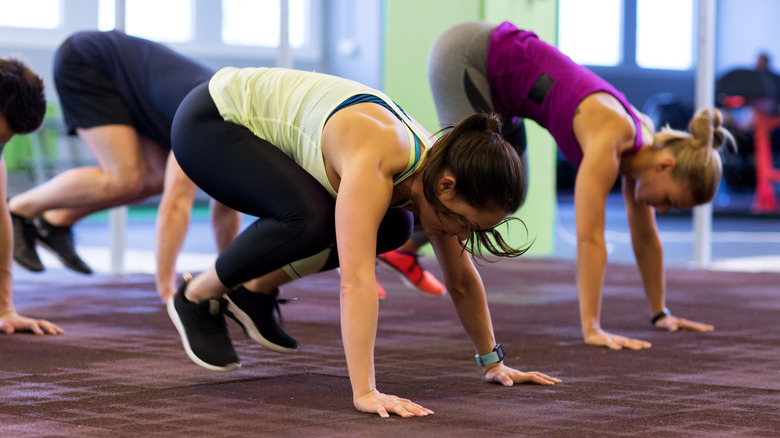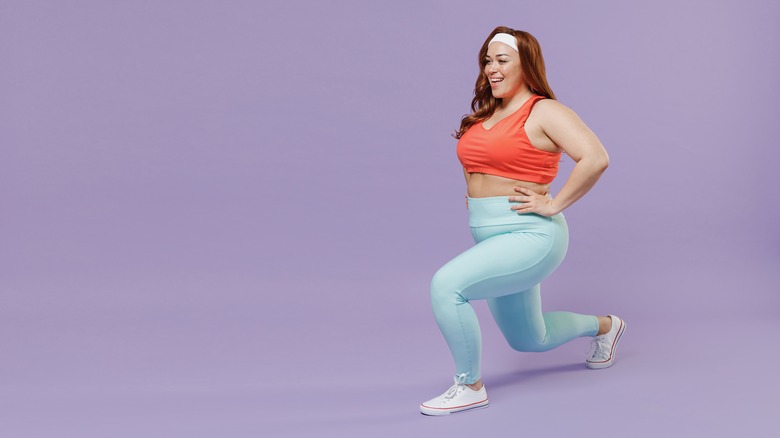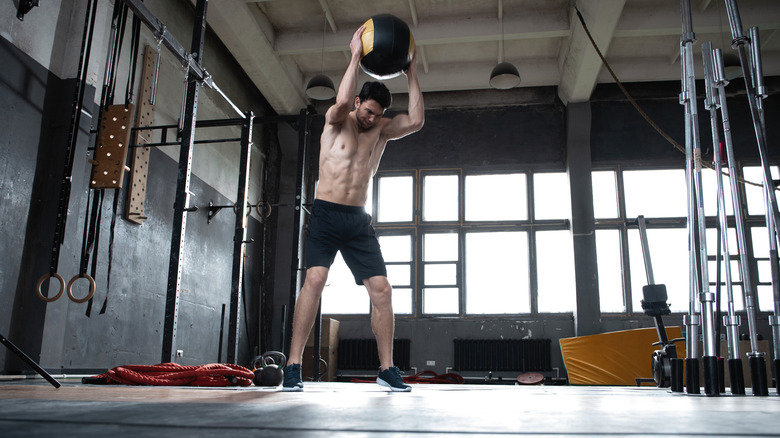Exercises That Will Give You The Same Benefits As Burpees
Burpees are a great exercise to burn calories and boost strength. According to Healthline, doing 20 burpees per minute can burn 12.5 calories for a person weighing 155 pounds. Burpees work both the upper and lower body while also strengthening your heart and lungs. Best part? You don't need any equipment — just enough space to move and nice neighbors downstairs who don't mind your jumping.
However, some people might not be able to do a burpee. Men's Health believes they're "overrated" and can cause wrist, elbow, or shoulder injuries. Because burpees are often included as part of a HIIT or CrossFit workout, rushing through them can weaken the proper form.
Even if you hate burpees (or even if you love them), you could try similar exercises that provide the same heart-pumping, muscle-building benefits of burpees. With all of them, including burpees, you can't forget to engage your core. What does that mean? According to Shape, think of engaging your core like you're tightening your belt. This keeps your core and back muscles stable to protect your back and pelvis. Try some of these exercises as stand-alone warm-ups or substitute them for burpees — or you can put them all together into one exhausting circuit so you can get in a solid workout.
The jump squat
The jump squat – or squat jump — is a calorie torcher that is one part of the burpee that makes it so tough (per Self). It requires you to explode into the air and then land softly with stability. According to Women's Health, this move doesn't need weights; it's taxing enough on its own. The squat will fire your legs and butt, and the jump will work your lungs.
Start with your feet wider than shoulder width and toes pointed out slightly. Squat down, engaging your core and keeping your spine neutral. At the bottom of your squat, squeeze your glutes to get that extra fire going. Use that fire to drive through your heels and jump high. Your toes should also recruit your calves to help you push off, then try to land soft (via Women's Health).
If you're training for more power, try to sink deep into your squat to further engage your glutes and legs as you jump to your max height. If jump squats are part of a HIIT or circuit, your squat might not be as deep so you can fire off several of them for 15 to 45 seconds. If you're not used to burpees or jump squats, aim to incorporate the jump squat into your workouts once or twice a week to start.
The squat thrust
The squat thrust can help if you need to work on your hip mobility, according to Muscle & Fitness. You're also working your way to a full burpee but without a push-up or jump. You'll still get some cardio and lower body recruitment in this move while also using your core and shoulders to stabilize you. According to Coach, you'll start standing, then squat down so you can place your hands on the floor. As you engage your core to protect your back, kick your legs behind you so you wind up in an upper push-up position. Keeping your core stable, kick your legs forward to meet your hands as you come to a squat again, then stand up. That's one.
Muscle & Fitness reminds you to avoid dropping your hips as you jump back into the plank position. When jumping your feet back up to your hands, work on landing your feet flat. If you want a little stability when you thrust your legs forward and back, try using dumbbells to anchor you (via Coach).
The plyo lunge
Plyo lunges are great for getting your heart rate up while also building muscle, according to Master Class. If you're new to lunges or aren't quite stable with them, opt for walking lunges or reverse lunges until you can get the form down. Plyo lunges not only build strength, but they also allow a stretch in your legs at the same time.
Let's get the form of the lunge first. Step one foot as far forward as your mobility allows, then bend your knees and lower your hips so the back knee is close to the floor. Your front knee should be on the same track as your big toe, and your back hip bone should be above your back knee on the same line. You'll be on the toes of your back foot with the heel off the floor. Your chest should be up and slightly leaning forward (via Master Class).
Using your arms to help you launch, push your front foot into the floor and jump straight up, then switch legs in mid-air so your back leg is now the front. Reset your lunge posture, and repeat (via Master Class). Try 10 to 20 reps and see if you miss burpees yet.
The medicine ball slam
Got rage? The medicine ball slam might help. According to Barbend, medicine ball slams tax your core, lats, hips, and shoulders and work your coordination and balance. You can use them as part of a warm-up for your strength training or weave them into a HIIT. Or you can do them to let loose after a stressful day at the office.
Coach suggests choosing a medicine ball that is heavy enough to give you a good amount of resistance during the slam and the pickup, but not too heavy that you'll put a hole in your floor. Bring the ball overhead, and with one movement, slam the ball hard as you squat low. Be sure to hinge your hips back rather than bending at the waist so you're targeting your glutes and hamstrings. When the ball hits the floor, catch it on your way back to standing. Try three sets of 12 to 15 reps, or aim for a time goal as part of a HIIT session.
Thrusters
Don't confuse thrusters with squat thrusts or you'll miss a great front squat and overhead press combo, according to Healthline. Thrusters will get your heart thumping hard when you thrust a heavy weight overhead. They will also help with your coordination, balance, and muscular endurance. Your quads, core, hamstrings, back, triceps, shoulders, and core will all feel the thruster.
You can start with either a dumbbell or barbell, but start light until you get the basic movement correct. Although the thruster combines the front squat and overhead press, the movement should be fluid and controlled. Using an overhand grip and feet shoulder-width apart, lift the weight to your collarbones, just as you would for a standard overhead press. Your shoulders should be back and down, and yes, your core is still engaged. This is your starting position (via Healthline).
Lower into a squat, keeping the weight at your collarbones. In one solid movement, press through your heels and drive you and the weight up. Use the momentum of your squat to send the weight overhead. When the weight is overhead, be sure not to have it too far behind your head or in front of your head. That's why this move requires a little balance and coordination (via Healthline).
Try any of these options the next time your workout requires burpees. They might improve your burpee form, or they might become your next favorite.

